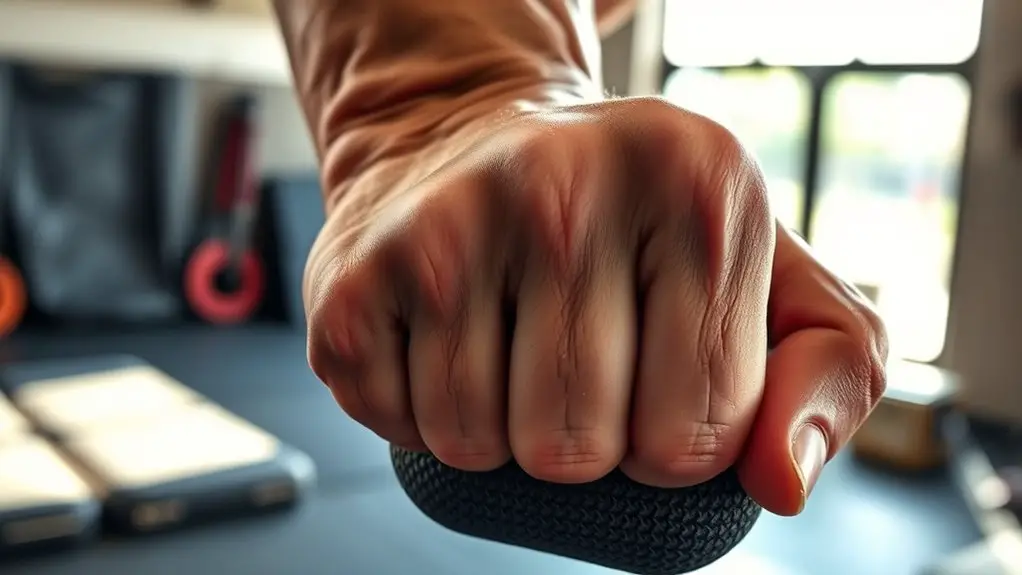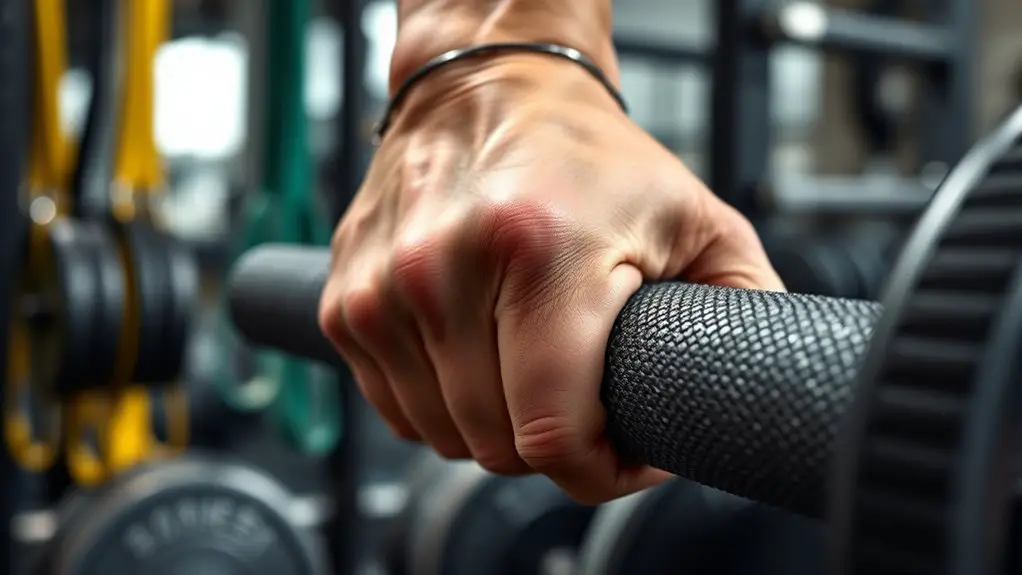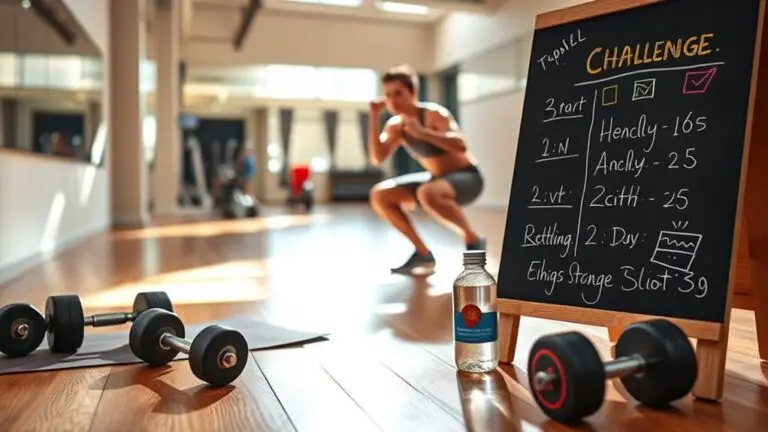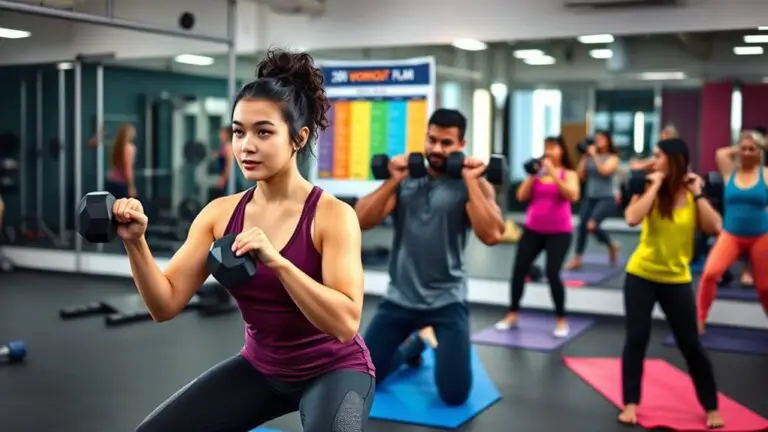How to Train Grip Strength for Grappling Sports

To train your grip strength for grappling sports, incorporate exercises like dead hangs and towel hangs to enhance endurance and finger stability. Farmer’s walks and plate pinches are great for overall grip strength. Use tools like hand grippers and thick bars for progressive resistance. Integrating grip drills into your training routine and practicing specific grip techniques during sparring can also boost your performance. There’s a lot more to discover about effective training strategies that can elevate your game.
Understanding the Importance of Grip Strength in Grappling

Grip strength is an essential element in grappling sports, often serving as the foundation for control and technique. It’s not just about holding on; it’s about maintaining advantageous positions and executing effective grappling techniques. A strong grip allows you to manipulate your opponent’s movements, limiting their options and enhancing your control on the mat.
The importance of grip extends beyond mere strength; it influences your ability to perform various techniques, from takedowns to submissions. For instance, a firm grip during a choke can make the difference between success and failure, while weak grip strength can lead to quick escapes by your opponent.
In grappling, the ability to maintain your hold while shifting between positions is critical. Consequently, developing grip strength is essential for any serious grappler looking to improve their performance and overall effectiveness in competition. Prioritizing grip work in your training will pay off considerably.
Key Grip Strength Exercises for Grapplers
To develop robust grip strength for grappling, incorporating specific exercises into your training regimen is essential. Start with dead hangs, where you hang from a pull-up bar to build endurance. Progress to towel hangs, using a towel draped over the bar to create grip variations that challenge your forearms. Farmer’s walks are another excellent choice—carry heavy weights in each hand for distance to improve grip strength while engaging your core.
Don’t forget about plate pinches, where you hold weight plates between your fingers for time. This exercise enhances finger strength and stability. Finally, consider incorporating grip strength assessments, like using a dynamometer, to measure your progress and tailor your workouts accordingly. By focusing on these exercises, you’ll develop the grip strength vital for gaining an advantage on the mat.
Incorporating Grip Training Into Your Routine

To effectively incorporate grip training into your routine, start by committing to daily exercises that target your grip strength. Consider using equipment like grip trainers or towels for added resistance, and don’t forget to integrate grip drills into your existing workouts. This approach not only enhances your overall strength but also complements your grappling skills seamlessly.
Daily Grip Exercises
While many athletes focus on specific techniques and conditioning for grappling sports, incorporating daily grip exercises into your routine can greatly enhance your overall performance. By practicing dynamic grip techniques, you can target different grip strength variations that are essential in grappling. Try exercises like towel wringing, where you twist a towel to build wrist and forearm strength, or farmer’s walks, which enhance your grip endurance. Incorporate band stretches to improve flexibility and grip control. Even simple actions, like using a stress ball during breaks, can contribute to your grip training. Make these exercises a part of your daily regimen, and you’ll notice improvements in your ability to control your opponent and maintain dominant positions on the mat.
Equipment for Grip Training
Incorporating the right equipment into your grip training can greatly amplify the benefits of your daily exercises. Utilizing specific grip training tools can enhance your strength and endurance, essential for grappling sports. Consider investing in grip strength equipment like hand grippers, which allow you to progressively increase resistance; this helps build your forearm muscles effectively. Resistance bands can also be useful, offering versatile grip challenges. Another great option is a thick bar or fat grip, which forces your hands to work harder, improving overall grip strength. Finally, tools like a wrist roller can target your wrist and forearm muscles specifically. Integrating these items into your routine will guarantee you’re effectively developing the grip strength necessary for grappling success.
Integrating Grip Drills
A well-structured routine that includes grip drills can greatly enhance your grappling performance. To effectively integrate grip training, consider incorporating dynamic grip variations into your workouts. For example, use exercises like plate pinches or towel wringing to challenge your grip in different ways. It’s also essential to make sport-specific adaptations; for instance, if you’re into Brazilian Jiu-Jitsu, practice gripping techniques that mimic those used during matches. Schedule these drills at least twice a week, pairing them with your regular strength and conditioning sessions. This approach not only builds grip strength but also improves your overall control and endurance on the mat, giving you a competitive edge in your grappling endeavors.
Utilizing Equipment for Enhanced Grip Strength

Several effective tools can greatly enhance your grip strength for grappling sports. Incorporating grip tools into your training can yield significant benefits. Start with hand grippers, which come in various resistance levels, allowing you to progressively increase difficulty. They target the fingers, hands, and forearms, essential for grappling.
Resistance bands are another versatile option. You can perform exercises like wrist curls or reverse curls, promoting both grip strength and wrist stability. Anchoring the band and pulling can also mimic the pulling motions used in grappling, making your training more sport-specific.
Don’t overlook the use of thick bars or fat grips, which force your hands to work harder. This increase in difficulty translates to improved grip strength when engaging in grappling. By incorporating these tools into your routine, you’ll build the grip strength necessary for effective performance on the mat.
Specific Techniques for Improving Grip During Sparring
While sparring, employing specific grip techniques can greatly enhance your performance and control over your opponent. One effective strategy is to focus on the “monkey grip,” where you keep your fingers fully extended and engaged around your opponent’s wrist or sleeve. This grip provides stability and prevents them from breaking away easily. Another useful technique is the “palm-up grip,” which allows you to pull down and control your opponent’s movements more effectively.
In addition, practicing “two-on-one” grips during sparring can improve your ability to control both their posture and movements. Incorporating these grip techniques into your sparring strategies not only develops your strength but also enhances your tactical advantage. Remember to vary your grips throughout sparring sessions to adapt to different scenarios, ensuring you’re prepared for various opponents and situations. By integrating these techniques, you’ll find your grip strength and overall performance improving considerably.
Tracking Progress and Setting Goals for Grip Strength

Tracking your progress in grip strength isn’t just about lifting heavier weights; it involves a systematic approach to measuring improvements over time and setting specific, achievable goals. By effectively implementing progress tracking and goal setting, you can optimize your grip training.
Tracking grip strength progress requires a structured method for measuring improvements and setting realistic goals to enhance your training.
Here are three key strategies to help you stay on track:
- Regular Assessments: Test your grip strength every 4-6 weeks using tools like hand grippers or a dynamometer. Record your results to visualize your progress.
- SMART Goals: Set Specific, Measurable, Achievable, Relevant, and Time-bound goals. For example, aim to increase your grip strength by 10% over the next month.
- Training Logs: Keep a detailed training log that includes exercises, weights, and reps. This helps you identify what works and where you need to adjust your training.
Frequently Asked Questions
How Does Diet Affect Grip Strength Development?
Diet plays an essential role in grip strength development. You’ll want to focus on nutrient timing, ensuring you consume protein sources like lean meats, legumes, and dairy post-workout. This helps repair and build muscle, enhancing grip strength over time. Additionally, maintaining a balanced diet rich in vitamins and minerals supports overall muscle function. So, pay attention to what you eat and when; it can greatly impact your grip strength progress.
Can Grip Strength Training Prevent Injuries in Grappling?
You might not realize it, but grip strength training could be your secret weapon for injury prevention. By incorporating specific strengthening techniques, you can enhance your grip endurance and stability, reducing the risk of sprains or strains during intense grappling sessions. Research shows that athletes with stronger grips often experience fewer injuries. So, don’t underestimate the power of those seemingly simple exercises; they could very well be the key to keeping you on the mat.
What Are Common Mistakes in Grip Training?
When it comes to grip training, there are a few common errors you might make. One is overtraining, which can lead to fatigue and injury. Another is neglecting to incorporate a variety of grips; sticking to ineffective techniques might limit your progress. Additionally, not focusing on proper form can hinder strength gains. To maximize your grip training, make certain you’re varying your exercises and allowing adequate recovery time for best results.
How Often Should I Train Grip Strength?
To effectively train grip strength, consider frequency guidelines that suggest training 2-3 times a week. This allows your muscles to recover while still promoting strength gains. You can integrate grip training into your existing training schedules, focusing on different exercises each session to avoid overuse. Make certain to listen to your body; if you’re feeling fatigued, it’s okay to adjust your training frequency to guarantee ideal results and prevent injury.
Are There Age-Specific Considerations for Grip Strength Training?
When it comes to grip strength training, age matters. For youth training, focus on developing proper techniques and building foundational strength through bodyweight exercises. It’s essential to avoid overloading young joints. Conversely, seniors may need specific adaptations, like lower resistance and more recovery time, to enhance grip strength safely. Tailoring your approach to these age-specific considerations guarantees effective training while minimizing risks. Prioritizing age-appropriate methods leads to better outcomes for everyone involved.





